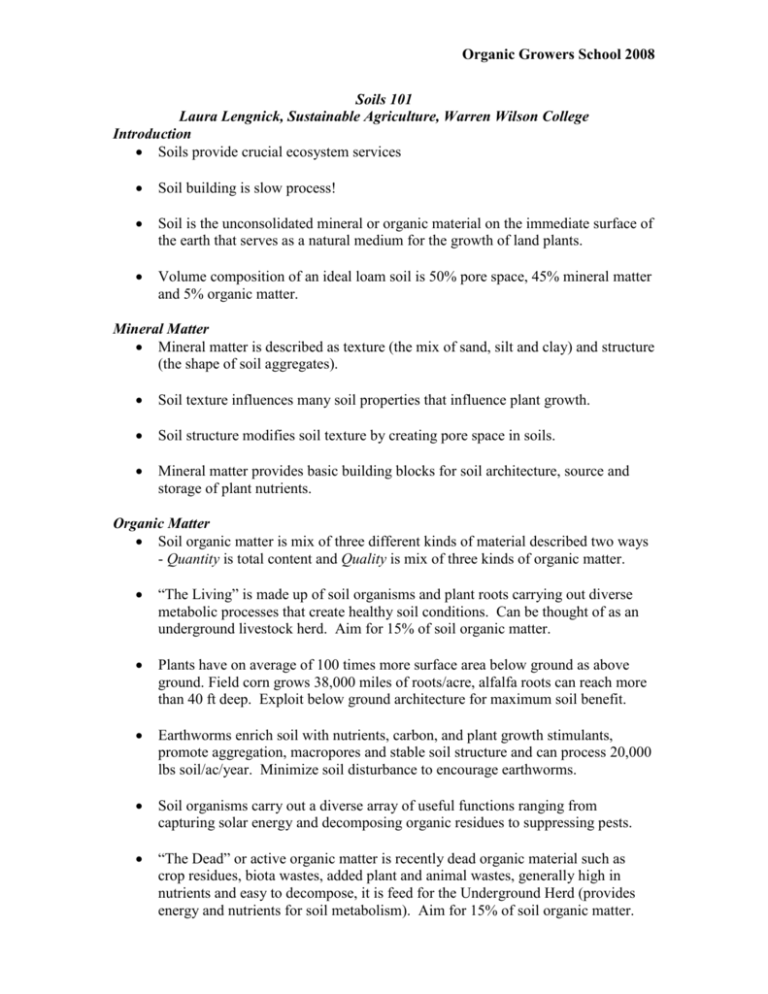Organic Matter
advertisement

Organic Growers School 2008 Soils 101 Laura Lengnick, Sustainable Agriculture, Warren Wilson College Introduction Soils provide crucial ecosystem services Soil building is slow process! Soil is the unconsolidated mineral or organic material on the immediate surface of the earth that serves as a natural medium for the growth of land plants. Volume composition of an ideal loam soil is 50% pore space, 45% mineral matter and 5% organic matter. Mineral Matter Mineral matter is described as texture (the mix of sand, silt and clay) and structure (the shape of soil aggregates). Soil texture influences many soil properties that influence plant growth. Soil structure modifies soil texture by creating pore space in soils. Mineral matter provides basic building blocks for soil architecture, source and storage of plant nutrients. Organic Matter Soil organic matter is mix of three different kinds of material described two ways - Quantity is total content and Quality is mix of three kinds of organic matter. “The Living” is made up of soil organisms and plant roots carrying out diverse metabolic processes that create healthy soil conditions. Can be thought of as an underground livestock herd. Aim for 15% of soil organic matter. Plants have on average of 100 times more surface area below ground as above ground. Field corn grows 38,000 miles of roots/acre, alfalfa roots can reach more than 40 ft deep. Exploit below ground architecture for maximum soil benefit. Earthworms enrich soil with nutrients, carbon, and plant growth stimulants, promote aggregation, macropores and stable soil structure and can process 20,000 lbs soil/ac/year. Minimize soil disturbance to encourage earthworms. Soil organisms carry out a diverse array of useful functions ranging from capturing solar energy and decomposing organic residues to suppressing pests. “The Dead” or active organic matter is recently dead organic material such as crop residues, biota wastes, added plant and animal wastes, generally high in nutrients and easy to decompose, it is feed for the Underground Herd (provides energy and nutrients for soil metabolism). Aim for 15% of soil organic matter. Organic Growers School 2008 “The Very Dead” is soil humus representing the end products of soil metabolism. Humus is very physically and chemically active and stores nutrients and water, stabilizes soil structure, inactivates/degrades toxins, and promotes plant growth. Humus can be thought of as “The Farm” for the Underground Herd. Aim for 70% of soil organic matter. What Makes a Healthy Soil? Good tilth – strong structure, many macropores, Supply sufficient plant nutrients w/o excess, Supply sufficient water and air to plants, Support high populations of beneficial organisms, Suppress populations of pest organisms, Stable (resists degradation), Resilient (recovers quickly after damage). How to Build a Healthy Soil? Increase soil organic matter quantity by managing soil carbon so that additions > losses. This is not easy! 90% of added carbon lost in 1st year. Aim for realistic level (2 to 4% in SE) Increase organic matter quality with diverse organic matter additions through the use of crop rotation, cover crops, animal manures, and composts. Protect soil organic matter from loss by covering soils with crop canopy, cover crops and mulches and minimizing soil disturbance with tillage. Organic Matter is the Key to Soil Health! Useful Resources Building Soils for Better Crops. F. Magdoff and H. van Es. Sustainable Agriculture Network, Handbook Series, Book 4. ISBN 1-888626-05-4. This publication is published to the web and can be downloaded at no charge from http://www.sare.org/publications/bsbc/bsbc.pdf. Sustainable Soil Management, P. Sullivan, 2004, ATTRA. This publication is published to the web and is available at no charge from http://attra.ncat.org/attrapub/PDF/soilmgmt.pdf Grow Biointensive, is a program of Ecology Action a non-profit dedicated to small-scale, sustainable agriculture. They have a publication, How to Grow More Vegetables that presents a very effective small-scale method for rapidly improving soil health that can be purchased from their website http://www.growbiointensive.org/. Soil Biology Primer is a publication of the Natural Resources Conservation Service, an agency of USDA. The Primer provides an excellent introduction to soil organisms and their role in soil and plant health. This publication is available at no charge from http://soils.usda.gov/sqi/concepts/soil_biology/biology.html







